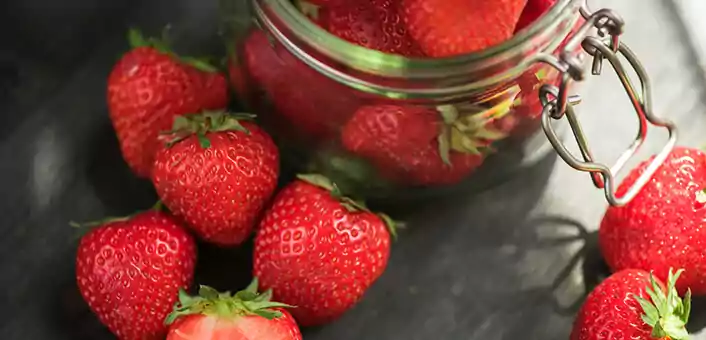PCOS test is based on the Rotterdam criteria for diagnosing PCOS.

Living Well
One of the biggest challenges of a low-carb diet is to be able to eat enough fruits. If you are on a strict LCHF Diet (low carb-high fat) or a Keto Diet, you may even be cutting out ALL fruit from your diet. It’s true – fruits are high in carbs and natural sugars. But there is one fruit that works well with any low-carb diet — and that’s the humble strawberry. Let’s look at the amount of carbs in strawberries and the many benefits of this fruit.
Like any other fruit, there are some carbs in strawberries. However, as a fruit rich in water and fiber, these have low total carb content. There are less than 8 grams of carbs in strawberries (100 grams.) To put this in perspective, 100 grams of bananas have 23 grams of carbs (that’s nearly 4 times the arbs in strawberries.)
These carbs in strawberries are in the form of simple sugars like glucose, sucrose, and fructose. So, 100 grams of strawberries contain only 32 calories because they contain 91% water.
Apart from keeping your carb intake in check, there are numerous benefits of adding this fruit to your diet.
The carbs in strawberries contain 26% fiber, which is why the net carb content of a cup of the fruit is so low. Each cup of whole strawberries contains 3 grams of dietary fiber – a mix of both soluble and insoluble fiber. These fibers help improve gut health and aid in healthy digestion. They also ensure that the simple sugars contained in them are absorbed in the blood slowly, preventing blood sugar spikes.
Strawberries have a low Glycemic Index (GI) of 40, which makes them safe for diabetics. Also, they have a very low Glycemic Load (GL) — half a cup has a GL of only 1.5. Glycemic Load takes into account the relationship between serving size and carbohydrate content. GL may be a better indicator of how any food containing carbs affects blood sugar levels. The antioxidants in them (namely ellagitannins and ellagic acid) add to the many benefits of strawberries. These antioxidants have good potential for the management of hyperglycemia and hypertension linked to type 2 diabetes.
Strawberries are rich in Vitamin C, which makes them excellent for skin and immune health. They also contain manganese, potassium, and folate (Vitamin B9) which are all important for essential body functions. They are loaded with plant antioxidants and other compounds, which offer numerous health benefits by fighting against free radicals.
Strawberries are rich in natural anthocyanin antioxidants, which help boost brain function. They also help reduce advancing age-induced oxidative stress, inflammatory responses, and diverse degenerative diseases. Degenerative diseases are problems that worsen with time. Berry anthocyanins also improve neuronal and cognitive brain functions and eye health.
While the fiber in strawberries prevents blood sugar spikes, the anthocyanin antioxidants also work well for postprandial inflammation and insulin sensitivity. Benefits of strawberries also include a natural reduction in the levels of C-reactive protein (CRP) in the blood which causes inflammation. This makes them a must-add to your anti-inflammatory diet.
The phytochemicals in strawberries, particularly anthocyanins and ellagic acid, have been associated with significant heart health benefits. In a study published in Nutrition Journal 2009, Freeze-dried Strawberry Powder improved lipid profile and lipid peroxidation in 16 women with metabolic syndrome. By consuming 2 cups of the strawberry drink daily for 4 weeks, their total cholesterol and LDL-cholesterol levels were significantly lowered by the end of the study.
The many antioxidants and flavonoids in the fruit can also help improve bone health, promote healthy weight loss, fight against oxidative stress, protect against premature signs of aging, and have even been linked to cancer prevention.
For maximum health benefits, it’s always a good idea to buy organic strawberries. Since these ripe red berries are very vulnerable to mold, regular crops are often treated with a lot of pesticides to increase their shelf life.
Look for perfectly ripe ones – these are the tastiest and the most nutrient-packed. Once picked, strawberries do not ripen further, so you want to avoid under-ripe or over-ripe berries. Strawberries that have been picked before they ripen to perfection are often dull in color and sour in taste. Overripe berries don’t taste good either.
The best strawberries are those bought locally when the fruit is in-season. Yes, you can buy them almost all through the year these days, but that doesn’t mean you’re going to get the best quality. Strawberries sold out-of-season or shipped long distances often have to be picked before they ripen, so they don’t pack the same nutritional (or flavor) punch as the perfect ripe fruit. If strawberries are not in season, you’d be better off with a bag of Fresh & Frozen strawberries as compared to the out-of-season offerings at the fresh aisle.
Here are 5 tips for picking up the best strawberries:
Fresh strawberries can be frozen for up to 6 months. So buy a large batch of local strawberry in season, and store them for the next 6 months by freezing them.
Some people can be allergic to strawberries. This is especially important for those with pollen-food allergy. Strawberry allergy can cause swelling of the lips, mouth and tongue, or hives, rash, headaches, and in severe cases, breathing problems. If you do have food allergies and are trying strawberries for the first time, consult a medical expert before having them.
Berry anthocyanins as novel antioxidants in human health and disease prevention – https://onlinelibrary.wiley.com/doi/10.1002/mnfr.200700002/full
Strawberry anthocyanin and its association with postprandial inflammation and insulin – https://www.cambridge.org/core/journals/british-journal-of-nutrition/article/strawberry-anthocyanin-and-its-association-with-postprandial-inflammation-and-insulin/FED139EE31DA31AC60C82F231C82EBEA
Freeze-dried strawberry powder improves lipid profile and lipid peroxidation in women with metabolic syndrome: baseline and post intervention effects – https://nutritionj.biomedcentral.com/articles/10.1186/1475-2891-8-43
Inhibition of cellular transformation by berry extracts – https://www.ncbi.nlm.nih.gov/pubmed/11181460
Evaluation of antiproliferative, anti-type 2 diabetes, and antihypertension potentials of ellagitannins from strawberries (Fragaria × ananassa Duch.) using in vitro models – https://www.ncbi.nlm.nih.gov/pubmed/20626254